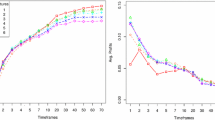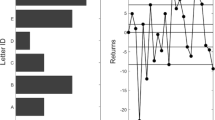Abstract
We present a machine learning approach using the sparse grid combination technique for the forecasting of intraday foreign exchange (fx) rates. The aim is to learn the impact of trading rules used by technical analysts just from the empirical behaviour of the market. To this end, the problem of analyzing a time series of transaction tick data is transformed by delay embedding into a D-dimensional regression problem using derived measurements from several different exchange rates. Then, a grid-based approach is used to discretize the resulting high-dimensional feature space. To cope with the curse of dimensionality we employ sparse grids in the form of the combination technique. Here, the problem is discretized and solved for a collection of conventional grids. The sparse grid solution is then obtained by linear combination of the solutions on these grids. We give the results of this approach to fx forecasting using real historical exchange data of the Euro, the US dollar, the Japanese Yen, the Swiss Franc and the British Pound from 2001 to 2005.
Access this chapter
Tax calculation will be finalised at checkout
Purchases are for personal use only
Similar content being viewed by others
Notes
- 1.
Observe that a change of 1. 0 − 4 in our target attribute is roughly the size of a pip (the smallest unit of the quoted price) for eur/usd.
- 2.
Different back ticks might result in a better performance, but we restricted our experiments to equal back ticks for reasons of simplicity.
- 3.
Note that a different order might result in a different performance.
- 4.
Furthermore only relatively few trades take place with fma which makes this a strategy with a higher variance in the performance.
References
D. J. E. Baestaens, W. M. van den Bergh, and H. Vaudrey. Market inefficiencies, technical trading and neural networks. In C. Dunis, editor, Forecasting Financial Markets, pages 245–260. Wiley, 1996.
W. Brock, J. Lakonishok, and B. LeBaron. Simple technical trading rules and the stochastic properties of stock returns. The Journal of Finance, 47(5):1731–1764, 1992.
H.-J. Bungartz and M. Griebel. Sparse grids. Acta Numerica, 13:147–269, 2004.
Y.-W. Cheung and C. Y.-P. Wong. Foreign exchange traders in Hong Kong, Tokyo, and Singapore: A survey study. In T. Bos and T. A. Fetherston, editors, Advances in Pacific Basin Financial Markets, volume 5, pages 111–134. JAI, 1999.
R. Curcio, C. Goodhart, D. Guillaume, and R. Payne. Do technical trading rules generate profits? Conclusions from the intra-day foreign exchange market. Int. J. Fin. Econ., 2(4):267–280, 1997.
M. A. H. Dempster, T. W. Payne, Y. S. Romahi, and G. W. P. Thompson. Computational learning techniques for intraday FX trading using popular technical indicators. IEEE Trans. Neural Networks, 12(4):744–754, 2001.
M. Engel. Time series analysis. Part III Essay, University of Cambridge, 1991.
T. Evgeniou, M. Pontil, and T. Poggio. Regularization networks and support vector machines. Advances in Computational Mathematics, 13:1–50, 2000.
J. Garcke. Regression with the optimised combination technique. In W. Cohen and A. Moore, editors, Proceedings of the 23rd ICML ’06, pages 321–328, 2006.
J. Garcke. A dimension adaptive sparse grid combination technique for machine learning. In W. Read, J. W. Larson, and A. J. Roberts, editors, Proceedings of the 13th Biennial Computational Techniques and Applications Conference, CTAC-2006, volume 48 of ANZIAM J., pages C725–C740, 2007.
J. Garcke and M. Griebel. Classification with sparse grids using simplicial basis functions. Intelligent Data Analysis, 6(6):483–502, 2002.
J. Garcke, M. Griebel, and M. Thess. Data mining with sparse grids. Computing, 67(3):225–253, 2001.
J. Garcke and M. Hegland. Fitting multidimensional data using gradient penalties and the sparse grid combination technique. Computing, 84(1–2):1–25, April 2009.
T. Gerstner and M. Griebel. Dimension–Adaptive Tensor–Product Quadrature. Computing, 71(1):65–87, 2003.
F. Girosi, M. Jones, and T. Poggio. Regularization theory and neural networks architectures. Neural Computation, 7:219–265, 1995.
P. Grassberger and I. Procaccia. Characterization of strange attractors. Phys. Rev. Lett, 50:346–349, 1983.
M. Griebel, M. Schneider, and C. Zenger. A combination technique for the solution of sparse grid problems. In P. de Groen and R. Beauwens, editors, Iterative Methods in Linear Algebra, pages 263–281. IMACS, Elsevier, North Holland, 1992.
D. M. Guillaume, M. M. Dacorogna, R. R. Davé, U. A. Müller, R. B. Olsen, and O. V. Pictet. From the bird’s eye to the microscope: A survey of new stylized facts of the intra-daily foreign exchange markets. Finance Stochast., 1(2):95–129, 1997.
M. Hegland, J. Garcke, and V. Challis. The combination technique and some generalisations. Linear Algebra and its Applications, 420(2–3):249–275, 2007.
M. Hegland, O. M. Nielsen, and Z. Shen. Multidimensional smoothing using hyperbolic interpolatory wavelets. Electronic Transactions on Numerical Analysis, 17:168–180, 2004.
I. Horenko. Finite element approach to clustering of multidimensional time series. SIAM Journal on Scientific Computing, 32:62–83, 2010.
K. Iwatsubo and Y. Kitamura. Intraday evidence of the informational efficiency of the yen/dollar exchange rate. Applied Financial Economics, 19(14):1103–1115, 2009.
H. Kantz and T. Schreiber. Nonlinear time series analysis. Cambridge University Press, 1997.
K. Lien. Day Trading the Currency Market. Wiley, 2005.
Y.-H. Lui and D. Mole. The use of fundamental and technical analyses by foreign exchange dealers: Hong Kong evidence. J. Int. Money Finance, 17(3):535–545, 1998.
A. L. M. Verleysen, E. de Bodt. Forecasting financial time series through intrinsic dimension estimation and non-linear data projection. In J. Mira and J. V. Sánchez-Andrés, editors, Engineering Applications of Bio-Inspired Artificial Neural Networks, Volume II, volume 1607 of Lecture Notes in Computer Science, pages 596–605. Springer, 1999.
C. J. Neely and P. A. Weller. Intraday technical trading in the foreign exchange market. J. Int. Money Finance, 22(2):223–237, 2003.
C. Osler. Support for resistance: Technical analysis and intraday exchange rates. Economic Policy Review, 6(2):53–68, 2000.
T. R. Reid. The United States of Europe, The New Superpower and the End of the American Supremacy. Penguin Books, 2004.
B. Schölkopf and A. Smola. Learning with Kernels. MIT Press, 2002.
F. Takens. Detecting strange attractors in turbulence. In D. Rand and L.-S. Young, editors, Dynamical Systems and Turbulence, volume 898 of Lecture Notes in Mathematics, pages 366–381. Springer, 1981.
M. P. Taylor and H. Allen. The use of technical analysis in the foreign exchange market. J. Int. Money Finance, 11(3):304–314, 1992.
A. N. Tikhonov and V. A. Arsenin. Solutions of ill-posed problems. W. H. Winston, Washington D.C., 1977.
G. Tsibouris and M. Zeidenberg. Testing the efficient markets hypothesis with gradient descent algorithms. In A.-P. Refenes, editor, Neural Networks in the Capital Markets, chapter 8, pages 127–136. Wiley, 1995.
G. Wahba. Spline models for observational data, volume 59 of Series in Applied Mathematics. SIAM, Philadelphia, 1990.
C. Zenger. Sparse grids. In W. Hackbusch, editor, Parallel Algorithms for Partial Differential Equations, Proceedings of the Sixth GAMM-Seminar, Kiel, 1990, volume 31 of Notes on Num. Fluid Mech. Vieweg-Verlag, 1991.
H. G. Zimmermann, R. Neuneier, and R. Grothmann. Multi-agent modeling of multiple FX-markets by neural networks. IEEE Trans. Neural Networks, 12(4):735–743, 2001.
Acknowledgements
We thank Bastian Bohn and Alexander Hullmann for their assistance with the numerical experiments.
Author information
Authors and Affiliations
Corresponding author
Editor information
Editors and Affiliations
Rights and permissions
Copyright information
© 2012 Springer-Verlag Berlin Heidelberg
About this paper
Cite this paper
Garcke, J., Gerstner, T., Griebel, M. (2012). Intraday Foreign Exchange Rate Forecasting Using Sparse Grids. In: Garcke, J., Griebel, M. (eds) Sparse Grids and Applications. Lecture Notes in Computational Science and Engineering, vol 88. Springer, Berlin, Heidelberg. https://doi.org/10.1007/978-3-642-31703-3_4
Download citation
DOI: https://doi.org/10.1007/978-3-642-31703-3_4
Published:
Publisher Name: Springer, Berlin, Heidelberg
Print ISBN: 978-3-642-31702-6
Online ISBN: 978-3-642-31703-3
eBook Packages: Mathematics and StatisticsMathematics and Statistics (R0)




